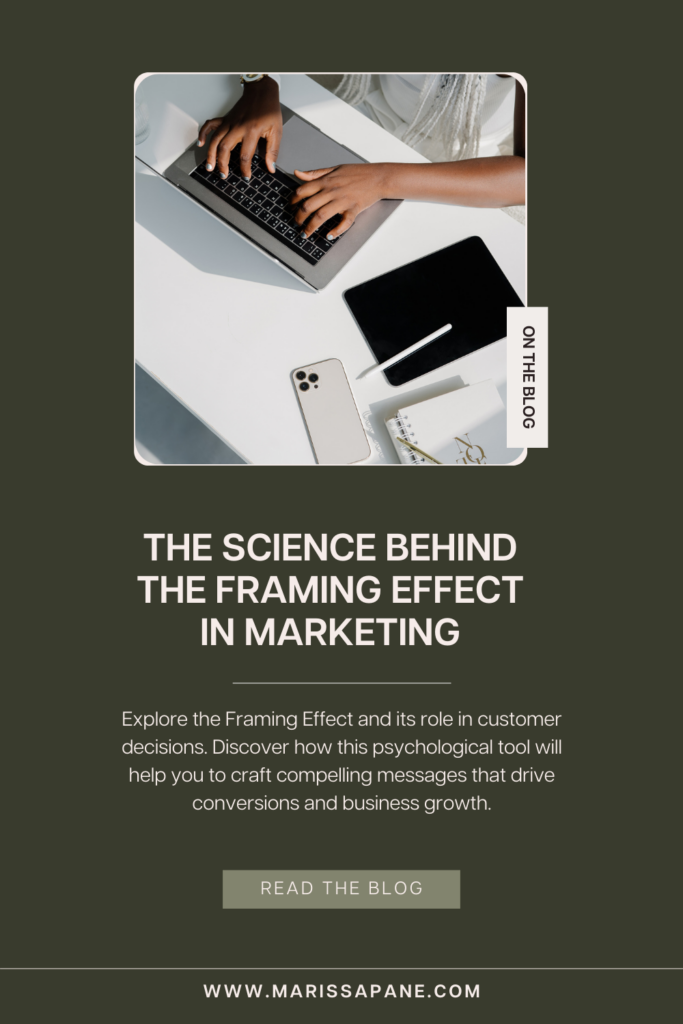Did you know that the way you present information to your customers affects how they respond? Identical information can be more or less attractive to your customers depending on what aspects are highlighted. This happens because of The Framing Effect.
Understanding the Framing Effect:
Your customers often rely on a cognitive bias called The Framing Effect to simplify their decision-making process. In simplest terms, The Framing Effect proves that the way you phrase (or word) information is crucial, as people make different decisions based on how the same information is presented to them.
If you were having a sale on your services, this offer could be expressed in two different frames: “Save 40% when you buy now” vs. “Don’t miss out on 40% off.”
It’s an identical offer but one frame emphasizes gain, while the other highlights potential loss.
The Emotional Aspect of Decisions:
Psychologists Daniel Kahneman and Amos Tversky’s “prospect theory” showed that people prioritize avoiding losses over achieving equivalent gains. Meaning that people will actively search for choices and knowledge that provide guaranteed benefits as opposed to enduring a possible loss.
If you’re wondering how this can happen, it’s simple: Your customer’s decisions are not rational.
Decisions are often emotional reactions to gains and losses.
“Gains and losses are short-term. They’re immediate, emotional reactions,” says Kahneman. He continues to say, “This makes an enormous difference to the quality of decisions. People put much more weight on losses than gains. People hate losing. And they hate losing much more than they enjoy winning.”
Crafting Compelling Copy Using Behavioral Science:
Isn’t it interesting how making slight changes to the way you present your message can significantly impact the conversion rate of your copy?
To make decisions faster, customers use heuristics or shortcuts. When writing copy for your products and services, consider that your customers’ brains use mental shortcuts like Framing to save time and energy. By understanding and ethically using these unconscious decision-making processes, you can effectively tap into their mindset to achieve the results you desire.
Examples of the Framing Effect At Work:
While grocery shopping, you come across two beef products that have the same cost and weight. One is labeled “80% lean” while the other is labeled “20% fat.” When you compare them, the idea that 20% fat is unhealthy influences your decision to choose the 80% lean option. In reality, both products are the same, but the way they are labeled affects your preference for the more appealing option due to the framing effect.
Now imagine, you reach the dairy aisle and spot two yogurt options: one labeled “90% sugar-free” and the other with “only 10% sugar.” Due to the framing effect, you are more inclined to select the 90% sugar-free option as it appears healthier than consciously choosing a yogurt with 10% sugar.
Here are a few more examples to show how this powerful cognitive bias influences decision-making:
Job Descriptions
- Frame A: “Flexible Hours for Work-Life Balance”
- Frame B: “Occasional Weekend Work Required”
Despite offering the same work hours, Frame A appeals to the desire for work-life balance, while Frame B introduces the notion of sacrificing weekends. Job seekers influenced by the Framing Effect may find Frame A more attractive, highlighting the impact of framing on our professional choices.
Technology
- Frame A: “Long-Lasting Battery, Up to 20 Hours of Use”
- Frame B: “Battery Needs Charging Every 4 Hours”
Both frames convey the same battery life, yet Frame A emphasizes endurance, while Frame B introduces the need for frequent charging. Consumers influenced by the Framing Effect may lean towards Frame A, perceiving the gadget as more reliable and convenient.
Financial Services
- Frame A: “0.5% Monthly Interest Rate”
- Frame B: “Annual Interest Rate of 6%”
While mathematically equivalent, Frame A might attract individuals who focus on the seemingly lower monthly rate, while Frame B appeals to those emphasizing the annual perspective. The Framing Effect plays a subtle yet influential role in financial decision-making.
Conclusion:
Understanding the Framing Effect provides a strategic advantage. It is not merely a cognitive bias, but a tool that savvy business owners can utilize to construct persuasive narratives, shape perceptions, and ethically enhance conversions. When crafting marketing messages, remember the significance of framing. By comprehending and employing the Framing Effect, you can engage with your customers’ emotions and influence their decisions.
Looking for more free content marketing and brand strategy insights?
Subscribe to the Content Pour-Over! It’s where I share my best actionable content marketing insights that will help you show up and show off your impactful brand. Expect a fresh brew to splash your inbox every Wednesday morning. ☕

